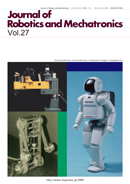27 巻, 2 号
選択された号の論文の12件中1~12を表示しています
- |<
- <
- 1
- >
- >|
Special Issue on Vision and Motion Control
-
原稿種別: Editorial
2015 年27 巻2 号 p. 121
発行日: 2015/04/20
公開日: 2019/07/01
PDF形式でダウンロード (60K) -
原稿種別: Review
2015 年27 巻2 号 p. 122-125
発行日: 2015/04/20
公開日: 2019/07/01
PDF形式でダウンロード (167K) -
原稿種別: Paper
2015 年27 巻2 号 p. 126-135
発行日: 2015/04/20
公開日: 2019/07/01
PDF形式でダウンロード (3884K) -
原稿種別: Paper
2015 年27 巻2 号 p. 136-145
発行日: 2015/04/20
公開日: 2019/07/01
PDF形式でダウンロード (1312K) -
原稿種別: Paper
2015 年27 巻2 号 p. 146-155
発行日: 2015/04/20
公開日: 2019/07/01
PDF形式でダウンロード (2972K) -
原稿種別: Paper
2015 年27 巻2 号 p. 156-166
発行日: 2015/04/20
公開日: 2019/07/01
PDF形式でダウンロード (1234K) -
原稿種別: Paper
2015 年27 巻2 号 p. 167-173
発行日: 2015/04/20
公開日: 2019/07/01
PDF形式でダウンロード (1273K) -
原稿種別: Paper
2015 年27 巻2 号 p. 174-181
発行日: 2015/04/20
公開日: 2019/07/01
PDF形式でダウンロード (2536K) -
原稿種別: Development Report
2015 年27 巻2 号 p. 182-190
発行日: 2015/04/20
公開日: 2019/07/01
PDF形式でダウンロード (856K)
Regular papers
-
原稿種別: Paper
2015 年27 巻2 号 p. 191-199
発行日: 2015/04/20
公開日: 2019/07/01
PDF形式でダウンロード (1709K) -
原稿種別: Paper
2015 年27 巻2 号 p. 200-207
発行日: 2015/04/20
公開日: 2019/07/01
PDF形式でダウンロード (1712K) -
原稿種別: Paper
2015 年27 巻2 号 p. 208-214
発行日: 2015/04/20
公開日: 2019/07/01
PDF形式でダウンロード (677K)
- |<
- <
- 1
- >
- >|
